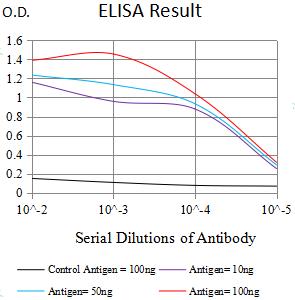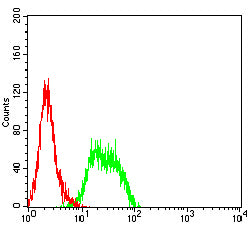


| WB | 1/500 - 1/2000 | Human,Mouse,Rat |
| IF | 咨询技术 | Human,Mouse,Rat |
| IHC | 咨询技术 | Human,Mouse,Rat |
| ICC | 技术咨询 | Human,Mouse,Rat |
| FCM | 1/200 - 1/400 | Human,Mouse,Rat |
| Elisa | 1/10000 | Human,Mouse,Rat |
| Aliases | CD246; NBLST3 |
| Entrez GeneID | 238 |
| clone | 3A5B3 |
| WB Predicted band size | 176.4kDa |
| Host/Isotype | Mouse IgG1 |
| Antibody Type | Primary antibody |
| Storage | Store at 4°C short term. Aliquot and store at -20°C long term. Avoid freeze/thaw cycles. |
| Species Reactivity | Human |
| Immunogen | Purified recombinant fragment of human ALK/p80 (AA: 1359-1460) expressed in E. Coli. |
| Formulation | Purified antibody in PBS with 0.05% sodium azide |
+ +
以下是关于ALK/p80抗体的3-4条参考文献及其简要摘要:
1. **文献名称**:*ALK, the chromosome 2 gene locus altered by the t(2;5) in non-Hodgkin's lymphoma, is a novel receptor tyrosine kinase*
**作者**:Morris, S.W., et al. (1994)
**摘要**:该研究首次报道了ALK(间变性淋巴瘤激酶)基因在染色体2上的异常重排(t(2;5)),导致其与核磷蛋白(NPM)基因融合,形成NPM-ALK融合蛋白(p80)。该发现揭示了ALK在间变性大细胞淋巴瘤(ALCL)中的致癌作用,并为开发针对ALK/p80的抗体提供了分子基础。
2. **文献名称**:*Molecular characterization of ALK, a receptor tyrosine kinase expressed in anaplastic large-cell lymphoma*
**作者**:Shiota, M., et al. (1994)
**摘要**:作者通过克隆ALK的cDNA,证实了其在正常组织中低表达,而在ALCL中因染色体易位显著高表达。研究还表明,针对ALK/p80的抗体可特异性识别肿瘤细胞中的融合蛋白,为ALCL的诊断和靶向治疗提供了依据。
3. **文献名称**:*Detection of anaplastic lymphoma kinase (ALK) and nucleolar protein nucleophosmin (NPM)-ALK proteins in normal and neoplastic cells with the monoclonal antibody ALK1*
**作者**:Pulford, K., et al. (1997)
**摘要**:该研究开发了单克隆抗体ALK1.用于检测NPM-ALK融合蛋白(p80)的表达。实验证明,ALK1抗体在ALCL组织切片中具有高敏感性和特异性,且不与正常组织交叉反应,成为病理诊断中重要的工具。
4. **文献名称**:*ALK expression in extranodal inflammatory myofibroblastic tumors: a potential diagnostic pitfall*
**作者**:Dogan, S., et al. (2002)
**摘要**:文章探讨了ALK/p80抗体在炎症性肌纤维母细胞瘤(IMT)中的表达情况,发现部分IMT病例存在ALK重排和蛋白过表达。研究提示,尽管ALK抗体在诊断ALCL中具有价值,但也需注意其在非淋巴瘤病变中的潜在表达,避免误诊。
以上文献涵盖了ALK/p80抗体的分子机制、诊断应用及临床意义,适用于肿瘤病理学和靶向治疗研究参考。
ALK/p80 antibodies are immunological tools used to detect anaplastic lymphoma kinase (ALK) and its phosphorylated form (p80), which play critical roles in cancer biology. ALK is a receptor tyrosine kinase initially identified in 1994 through its involvement in chromosomal translocations associated with anaplastic large cell lymphoma (ALCL). The most common translocation, t(2;5)(p23;q35), fuses ALK with nucleophosmin (NPM), generating the oncogenic NPM-ALK fusion protein. This constitutively active kinase drives aberrant cell proliferation and survival, making ALK a key diagnostic and therapeutic target in ALCL, inflammatory myofibroblastic tumors, and non-small cell lung cancer (NSCLC).
The term "p80" historically refers to the phosphorylated (activated) state of ALK at tyrosine 1604 (Y1604), a critical residue in its kinase domain. Antibodies targeting phosphorylated ALK (pALK or p80) specifically recognize this active form, aiding in the identification of ALK-driven malignancies and monitoring therapeutic response. Commercially available ALK/p80 antibodies are widely used in immunohistochemistry (IHC), Western blotting, and fluorescence in situ hybridization (FISH) to detect ALK rearrangements or overexpression. Their clinical utility has grown with the development of ALK inhibitors (e.g., crizotinib, alectinib), which show efficacy in ALK-positive cancers. However, interpretation requires caution, as non-specific staining or heterogeneous ALK expression patterns may occur. Ongoing research continues to refine ALK/p80 antibody applications in precision oncology.
×